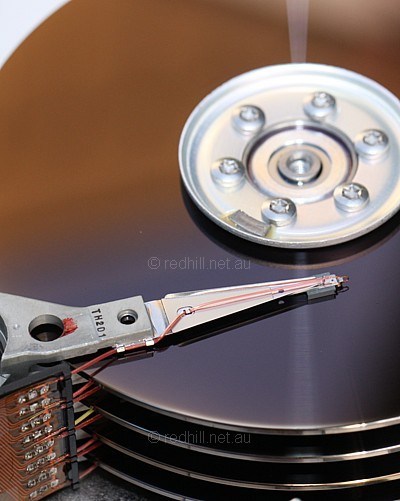
Fujitsu M2614ET (172MB, 1992).
Update your bookmark
This is the old site. You probably want the new site.
The new site has all the same information but adds more drives, updated text, and much better pictures of many models.
- IBM Deskstar 3
- Seagate Medalist 2132
- Maxtor 85120A8
- Seagate Medalist Pro 6.4
- Quantum Bigfoot CY new
- Seagate Cheetah
- Quantum Fireball TM
- Western Digital Caviar 1.05
- Seagate Medalist 4500
- Western Digital Caviar 1.28
- IBM Deskstar 4
- Western Digital Enterprise
- IBM Deskstar 5
- Quantum Fireball ST
- IBM Deskstar 8
This old version of the Red Hill guide hasn't been updated for about ten years. The new version can be found here.
This was the period when the Pentium 166 and the 6x86 200 were everywhere, when even the most conservative system buyers were starting to order Windows 95 rather than DOS and Windows 3.1, when 32MB of RAM was a lot, when 15 inch monitors became standard fare, and when 2.1GB and 3.2GB hard drives were the stand-out best choice on price-performance grounds. For us, it was an IBM year. We used IBM hard drives in about two-thirds of our systems, and IBM or IBM-manufactured processors in an even higher proportion of them.
(As always, the stars beside a drive indicate the volume it sold in. No stars means we didn't sell them new, one star, that we sold a mere handful, perhaps three or four individual ones or one batch of half a dozen. Four stars indicate a really popular drive; five stars, one of the all-time best sellers.)
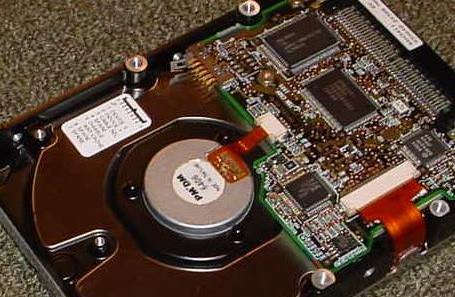
1997 Drive of the Year
IBM Deskstar 3 Family
Like the excellent IBM Deskstar 1.7 of the previous year, these superb drives were a technician's delight and a great illustration of the way drive manufacturers in general and IBM Storage in particular were using expensive new technology to make cheaper, faster, more reliable drives. Magneto-Resistive heads were more expensive than the older thin-film heads, but allowed such high data density that only three platters were required to store over 3GB (an outstanding achievement back then). The total cost was surprisingly low, and as an added bonus, the high areal density translated into very high data transfer rates.
There were just two versions, the 3.2, and the 2.1GB "depop". (A "depop" or depopulated drive is a larger model with one or more discs left out to reduce the capacity — and the cost too, of course. Nearly all drive models have depop versions.) The 2.1 was our best-selling drive for most of the earlier part of 1997, and the 3.2 took over for another few months after that. Only some classic weirdo IBM marketing stopped it going even longer — IBM started selling the bigger and faster 3.6GB Deskstar 4 for thirty-odd dollars less than the (by then over-priced) 3.2! Apparently this had to do with long-term OEM contracts, but IBM was always very good at the carefully aimed bullet in the foot.
Fast, cheap, and ultra-reliable, the Deskstar 3 was the obvious choice for 1997 Drive of the Year. Five years later we were still getting them traded in regularly, and they remained as they started: one of the most fuss-free and reliable drives we have ever sold.
| Performance | 1.00 | Reliability | AAA |
| Data rate | 88.4Mbit/sec | Spin rate | 5400 RPM |
| Seek time | 9.5ms | Buffer | 128k |
| Platter capacity | 1.05GB | Interface | IDE mode 4 |
| Read channel | PRML | Head technology | MR |
| DJAA-32160 | 2.1GB | 4 heads | ***** |
| DJAA-33280 | 3.28GB | 6 heads | **** |
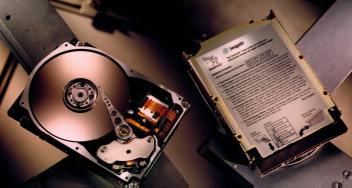
Seagate Medalist 2132
A fine drive, but introduced a little too late and shaded by faster models already available from IBM, Quantum and Western Digital. It was a little cheaper than most and thus worth considering where speed was not critical.
In the illustration, the one on the right is upside down; notice the unusual metal shield over the electronics. Seagate started doing this on a small number of drives a year or so before this model came out. Almost every Seagate drive was shielded by 1998 or 1999. JTS started the trend, putting shields on all its drives. The idea caught on fast and soon became a standard feature on several brands.
Also notice, though it's a little hard to see in this view, the distinctive Seagate "boat shape" casing, first seen in 100MB days, and common to a great many mid-range Seagate drives over the years: the Medalist 2132 was the very last of them.
| Performance | 0.84 | Reliability | AAX |
| Data rate | 68 Mbit/sec | Spin rate | 4504 RPM |
| Seek time | 12.5ms | Buffer | 128k |
| Platter capacity | 703MB | Interface | IDE mode 4 |
| Read channel | PRML | Head technology | thin film |
| ST32132A | 2.11GB | 6 heads | ** |
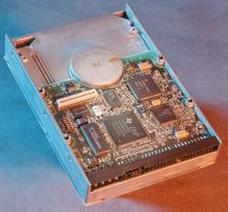
Maxtor Diamond Max 85120A8
One of the biggest IDE drives on the market when it appeared, and fast too. Maxtor had struggled in the last years prior to takeover by Hyundai — we avoided the fragile 540MB, 1GB and 2GB Maxtor products — but these 5GB monsters were the start of a serious fight back. We liked them.
The rejuvenated Maxtor had done some very nice things and by this time deserved to be reinstated at the top table. Maxtor was the only major drive maker to increase market share and turn a profit in 1997 — a year of severe oversupply and very poor margins for the storage industry — and it looked as though Maxtor had found its niche. At the time we wrote that Maxtor "will probably never be the major force it used to be in the early nineties." That seemed a safe enough prediction: but Maxtor would later to surprise us almost to the point of astonishment when it took over mighty Quantum in 2001. The lesson: don't ever make predictions about Maxtor!
There were a range of drives in the Diamond Max family, up to about 8GB, but the 5120 is the only model we carried at Red Hill. We sold a modest number of these before the 6GB Seagate and IBM drives arrived. Alas, over the years since then, their reliability was not particularly good. Industry sources assure us that Maxtor was much improved since its lowest ebb in 850MB and 2GB days and we merely had very bad luck with our handful of 5120s. We were convinced.
| Performance | 1.03 | Reliability | AA3 |
| Data rate | 107 Mbit/sec | Spin rate | 5400 RPM |
| Seek time | 10ms | Buffer | 256k |
| Platter capacity | 1.27GB | Interface | IDE mode 4 |
| Read channel | PRML | Head technology | MR |
| 85120A | 5.1GB | 8 heads | ** |

Seagate Medalist Pro 6.4
One of the first generation 6GB IDE drives, these were a bigger brother to the beautiful but failure prone Medalist Pro 2520.
Despite being essentially the same unit with extra platters, these had an excellent record and a very low return rate. They were a little expensive early on — 6.4GB was a huge drive at the time and few people were prepared to buy one — and towards the end of their long market life they were comprehensively out-performed by newer models, so the 6450 was never a big seller. We have never discovered if our happy experience with the 6.4 (as opposed to the 2.5) was just good luck or if Seagate found a way to improve reliability on the bigger model.
For some unfathomable reason, Seagate did some weird things with its model line up around this time: Seagate had outstanding high-end SCSI products, and a good range of entry-level 4500 RPM drives, but only two mainstream 5400 RPM IDE units: the slim-line 2.5 (which was too small by this time), and the 6.4 (which was too big). The market was asking for fast drives in the 4GB range, but Seagate had nothing. We sold a lot of IBM and Western Digital drives instead in '97. (The second model below was a running change, identical except that it supported ATA-33. Seagate list a third 5GB mode 4 model, but this appears not to have made it to Australia.)
| Performance | 1.03 | Reliability | AAX |
| Data rate | 116 Mbit/sec | Spin rate | 5397 RPM |
| Seek time | 10ms | Buffer | 512k |
| Platter capacity | 1.26GB | Interface | mode 4 or ATA-33 |
| Read channel | PRML | Head technology | MR |
| ST-36450A | 6.45GB | 10 heads | ** |
| ST-36451A | 6.45GB | 10 heads | * |
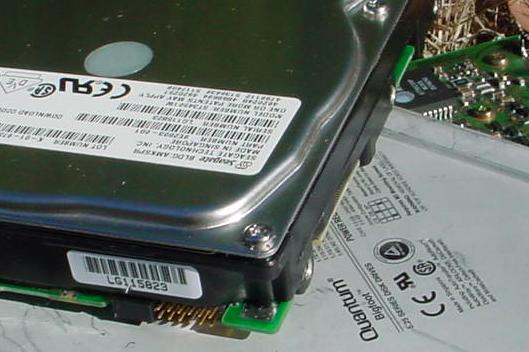
Seagate Cheetah Family
Easily the world's fastest hard drive. For a long time there was nothing else spinning at 10,000 RPM, and nothing else even came close to the data transfer rate the Cheetah produced: up to 21.3 megabytes a second. By way of comparison, a top-class 3 or 4GB IDE drive drive from the same era produced less than 7MB sec. Even the very best IDE drives could not match Cheetah 1 performance until nearly three years later when the third generation 7200s arrived.
→ In its day the fastest hard drive in the world by quite some margin, pictured with its exact opposite: Cheetah 1 and Bigfoot.
The real highlight of the Cheetah, however, was its blistering access times: the 7.7ms average seek was very special indeed and the 3.0ms latency that only a 10,000 RPM drive can produce was unique. At under 11ms total average access time, the 1997 Cheetah was streets in front of anything else on the market. For comparison, even five years later the fastest-seeking IDE drives were in the 13ms class.
At around two thousand dollars a pop when it first came out, the original Cheetah was hardly cheap, but pairing our 4.5GB Cheetah with a 686-200 or a K6-233 produced outstanding results — easily faster than any IDE-based system, even a much more expensive Pentium II. There were two models: 4.5GB and 9.1GB. Notice that the seek time is very slightly higher for the 9GB drive (because of the added mass of the extra heads).
The series 2 Cheetah was even faster. The data rate went up to an incredible 231M/bit sec, and the seek time was an astonishing 5.2ms — this was roughly half the seek time of most contemporary drives. If serious high-performance was your aim, and you were willing to part with around $1000 more than you'd pay for an IDE drive, then a Cheetah was a great idea. It cost about the same as the difference between a top-notch Socket 7 CPU and a high-end Slot 1 part. For business use, it was much more effective. Even for games it was worth considering. And if you were running a big server or an A/V workstation, the Cheetah had no peer.
| Cheetah 1 | Performance | 1.38 | |
| Data rate | 177 Mbit/sec | Spin rate | 10,033 RPM |
| Seek time | 7.7ms | Buffer | 512k |
| Platter capacity | 1.14GB | Interface | Fast wide SCSI |
| Read channel | PRML | Head technology | MR |
| ST-34501 | 4.55GB | 8 heads | 1/3 height |
| ST-19101 | 9.1GB | 16 heads | ½ height |
| Cheetah 2 (1998) | Performance | 1.63 | |
| Data rate | 231 Mbit/sec | Spin rate | 10,025 RPM |
| Seek time | 5.4ms | Buffer | 1MB |
| Platter capacity | 1.52GB | Interface | Ultra SCSI |
| ST-34502 | 4.55GB | 6 heads | 1/3 height |
| ST-39102 | 9.1GB | 12 heads | 1/3 height |
| ST-118202 | 18.2GB | 24 heads | ½ height |
| Cheetah 3 (1999) | Performance | 1.74 | |
| Data rate | 308 Mbit/sec | Spin rate | 10,016 RPM |
| Seek time | 5.2ms | Buffer | 1MB |
| Platter capacity | 3GB | Interface | Ultra 160 |
| ST-318203 | 18.2GB | 12 heads | 1/3 height |
| ST-136403 | 36.4GB | 24 heads | ½ height |
Quantum Fireball TM
Quantum's original Fireball drives were very high performance drives indeed, matched only by Seagate's Decathlon range. For year after year the Fireball vs Decathlon contest raged, with both companies having a fair share of wins and losses.
Unfortunately, Quantum's marketing department got into the habit of using "Fireball" to describe all the Quantum 3.5 inch IDE drives, not just the high-performance models. This caused no end of confusion — and undoubtedly helped Quantum sell its slower 3.5 inch models to the unwary.
In its rather dishonest way, calling the TMs "Fireballs" made sense. But this was just the start: no marketing department was ever so deranged as Quantum's used to be, and they went on from there into flights of utter fantasy that fooled no-one. Amongst other exploits, Quantum touted the Atlas 10K II as "the fastest hard drive in the world" when it wouldn't actually exist as a shipping product for six months yet, and was clearly inferior to the well-established Seagate Cheetah X15 anyway; and retrospectively decided that the Atlas IV had somehow been "designed for Intel's Itanium!" We never quite worked out if the Quantum marketing team was terminally dishonest or just incredibly ignorant. No matter: as an independent drive company Quantum is gone now, and new owner Maxtor has hired different PR guys — which is a pity in a way: you could always rely on the Quantum PR team for an unexpected belly laugh.
Thankfully, there was nothing at all wrong with Quantum's design and engineering departments. Like most Quantum drives, the Fireball TMs were good products. They were relatively modest 4500 RPM units, but very high-tech in their day, and the high areal density and excellent seek performance made them almost as quick as many of the competing 5400 RPM products. We sold a moderate number of the the 2.5s and a handful of 3.2s new, and have often seen TMs traded-in since then. They were our first new Quantum drive since 170MB days. Notice the unusual odd number of heads in the 2.5. This has become common in more recent times but used to be quite a rarity.
| Performance | 0.95 | Reliability | AA2 |
| Data rate | 95 Mbit/sec | Spin rate | 4500 RPM |
| Seek time | 10.5ms | Buffer | |
| Platter capacity | 1.08GB | Interface | IDE mode 4 |
| Read channel | PRML | Head technology | MR |
| TM 2.5 | 2.5GB | 5 heads | ** |
| TM 3.2 | 3.2GB | 6 heads | * |
Western Digital Caviar 1.05
We picked the AC22100 to replace the best-selling IBM Deskstar 3 when that drive was discontinued. It had been a long, long time since we had stocked new Western Digitals — not since the Caviar 850 — and it was nice to see them back on the shelf.
In the meantime WD had experienced its share of difficulties, including the famous AC31600 quality control disaster which ended up with a mass recall. We were not sorry to have missed that model and, looking back, we did the right thing in staying with Seagate and IBM right through the 1GB to 2GB era. Quantum buyers were well served also at this time, but both Maxtor and Western Digital dealers were going through the horrors. Both firms would recover in time — indeed, as we update this entry again in the southern Autumn of 2002, Maxtor and Western Digital are generally regarded as the best two brands.
Through 1997 WD declined to publish key performance figures — usually a sign that competing products are faster — but our own testing showed that although the bigger WD drives were off the pace, the AC22100 was one of the the quickest 2GB drives still in production. 2GB was by then the entry-level, and the competing drives were either 4500 RPM models like the Seagate Medalist 4500 or the still slower 5.25 inch Quantum Bigfoot. The top-line models had moved on.
As is nearly always the case with Western Digital drives, these were fast, beautifully finished, and backed by WD's warranty service (superb in those days, only Seagate were as good). Once the IBM Deskstar 3 started showing its age, the AC33100 became our standard 3GB drive. We never stocked the 1.05 and 2.56GB models in this family. Note the unusual 5200 RPM spindle speed, a traditional Western Digital oddity.
| Performance | 0.96 | Reliability | AA1 |
| Data rate | 104 Mbit/sec | Spin rate | 5200 RPM |
| Seek time | 12ms | Buffer | 128k |
| Platter capacity | 1.05GB | Interface | IDE mode 4 |
| Read channel | PRML | Head technology | thin film |
| AC11100 | 1.05GB | 2 heads | |
| AC22100 | 2.11GB | 4 heads | **** |
| AC32500 | 2.56GB | 5 heads | |
| AC33100 | 3.16GB | 6 heads | *** |
Seagate Medalist 4500 Family
The last of the line. These were the last mainstream drive to be made with thin-film head technology, and the last 3.5 inch drive to spin at 4500 RPM. We had been expecting these to go end-of-life for quite a while before they did, as their once-respectable performance was getting further and further off the pace while the months rolled by.
The Medalist 4500s were never intended to be high-speed drives, just a cost-effective product for the entry-level market. They competed with Quantum's Bigfoot and a number of little-known drives from the minor makers, not with the 5400 RPM mainstream units. And while we thought they were sluggish by comparison with a Deskstar or a Fireball, they were certainly faster than a Bigfoot.
In keeping with our long-held preference for high-speed drives, we sold only a modest number of Medalist 4500s, though the 2.1GB ST32122A was popular for a while in mid-1997 before we switched to the much faster Western Digital 2.0 and 2.1GB drives. The cost difference between these and a 5400 RPM drive was very small by then; less than $10. (The original versions of these — same model numbers but ending in zero — came out supporting ATA Mode 4; the Ultra ATA interface was a running change.)
Footnote: February 2001. Having completely disappeared off the market for a couple of years, 4500 RPM class drives become quite common again for a while, with Quantum's Fireball LCT series (all 4400 RPM units) and a short lived Western Digital model too. It should be no surprise to find that they were poor performers, though the LCTs with their remarkably good seek performance stood up better than they ought to have done, largely because their entry level competitors — the 5400 RPM Seagate U Series drives — were themselves such poor performers.
Postscript: July 2005. The Fireball LCT didn't last well. Over the last several years, we have seen a surprisingly large number of failed LCTs, nearly always with the same fault: a burned-out chip on the board. It's always the same chip, and it is immediately visible: a good old-fashioned let-the-smoke-out sort of failure.
| Performance | 0.89 | Reliability | AA1 |
| Data rate | 87.8 Mbit/sec | Spin rate | 4500 RPM |
| Seek time | 12.5ms | Buffer | 128k |
| Platter capacity | 1.05GB | Interface | mode 4 or ATA-33 |
| Read channel | RLL | Head technology | thin film |
| ST32122A | 2.11GB | 4 heads | *** |
| ST33232A | 3.22GB | 6 heads | * |
| ST34342A | 4.32GB | 8 heads |
Western Digital Caviar 1.28 Family
WD was the last major maker to use thin-film head technology across its entire desktop model range — IBM, Seagate, Quantum, Maxtor and Fujitsu were all using MR heads before WD — and these were the last new thin-film drive of all, but excellent performers nevertheless. (If you are thinking that we just said the Seagate Medalist 4500 was the last thin-film drive, you are right! The WD came out well after the Medalist 4500, but ceased production earlier. Both drives can claim to be the "last", it depends on which way you count it.)
The 2.5GB AC22500 was very popular here at Red Hill, and great value for money. The 2.0GB AC22000 is mainly included for the sake of interest as we only sold a few dozen of this excellent but short-lived drive. It was our original replacement for the wonderful old IBM Deskstar 2.1, and was itself soon replaced on WD Australia's shelves (for some unknown reason) by the older and slightly slower AC22100 (above). Notice how the three WD 2GB drives form a neat sequence of shrinking head-count, lower cost, and higher performance. The pattern reached its logical conclusion a little later still with the two-head AC12100, which was the last of the Western Digital 2.1s. As a rule of thumb, the appearance of single platter drives used to signal the beginning of the end for a size category; in fact, only about half the manufacturers would usually do a single platter model — it's a finely balanced equation: was it better to tool up for a short production-run, low-cost new single platter drive, or just to keep on making the old two-platter model for a while longer?
| Performance | 0.99 | Reliability | AA1 |
| Data rate | 114 Mbit/sec | Spin rate | 5200 RPM |
| Seek time | 11ms | Buffer | 256k |
| Platter capacity | 1.28GB | Interface | mode 4 |
| Read channel | PRML | Head technology | thin film |
| AC12000 | 1.28GB | 2 heads | |
| AC22000 | 2.0GB | 3 heads | ** |
| AC22500 | 2.56GB | 4 heads | **** |
| AC33200 | 3.25GB | 5 heads | * |
| AC34000 | 4.0GB | 6 heads |
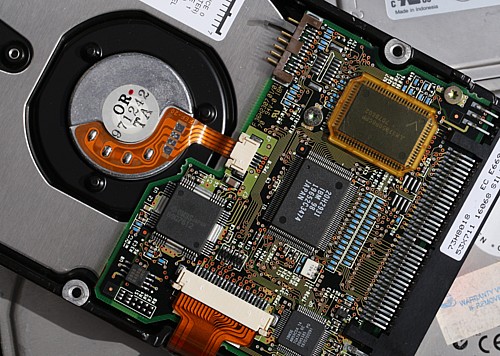
IBM Deskstar 4 Family
The two different drives in the Deskstar 4 family were identical except that the 3.6GB unit had only 5 heads. For no particular reason that we can think of, IBM didn't trouble to do the obvious and produce a three head or four head 2.1GB or 2.8GB version — one would have thought that if only two models were desired, they would have made them further apart in capacity.
For the second half of 1997, the 3.6GB Deskstar 4 was our most popular choice, which is unusual in an odd-sized drive: in general, the common capacities are the biggest sellers. For most of its life though, the 3.6GB Deskstar was about the same price as a 3.2GB drive — be it a Western Digital, a Seagate or, curiously, IBM's own 3.2GB Deskstar 3 — and this made it very hard to resist.
The 3.6GB Deskstar 4 also turned out to have the highest failure rate we have ever seen in an IBM drive — which was still pretty low! Many a lesser maker would have been more than happy with the record of the Deskstar 4.
| Performance | 1.04 | Reliability | AA2 |
| Data rate | 103.8 Mbit/sec | Spin rate | 5400 RPM |
| Seek time | 9.5ms | Buffer | 96k |
| Platter capacity | 1.44GB | Interface | mode 4 |
| Read channel | PRML | Head technology | MR |
| DCAA-33610 | 3.61GB | 5 heads | **** |
| DCAA-34330 | 4.33GB | 6 heads | ** |
Western Digital Enterprise Drives
For all its long-established prominence on the desktop, WD was never more than a bit player in the SCSI market. Tired of the poor profits to be found in the ultra competitive world of IDE, in late 1994 Western Digital decided to carve itself a place at the top table: the low volume but lucrative SCSI market. WD established a new division to design and manufacture SCSI drives and was shipping its first products by mid-1996.
Wisely, WD made the decision to concentrate on the mainstream lines where it could leverage its existing manufacturing skills, leaving the specialised ultra high-speed and ultra-high capacity models to the two giants of the SCSI market, IBM and Seagate.
Illustration: a pair of WDE4360s. Notice the different appearance: from the fancier label you would assume that the drive on the right is the newer of the two - cosmetic changes are usually made to improve the look of a drive, after all — but in fact the right-hand drive was made in 1997, the left-hand one in 1998.
There was to be a series of Enterprise drives in both 7200 and 10,000 RPM classes, in sizes up to 18GB. The earlier products in particular were well-placed to compete with the established players, being as fast or faster than all but the very latest and most expensive 7200 RPM drives from Seagate and IBM, and are priced very reasonably. But despite doing nearly everything right, Western Digital never did become a significant player in the SCSI world. Although SCSI drives wound up accounting for more than ten percent of WD's sales revenue, that was still not enough to make the Enterprise unit self-funding, particularly as WD was not the only company trying to break into the market. It was probably a little late to be getting into SCSI; margins were falling and development costs getting ever higher. The late '90s were to be a very difficult time for drive makers. After several years of losses in the mainstream IDE business, Western Digital simply ran out of money. WD sold its disc manufacturing facilities to Komag, dropped its notebook line, and at the beginning of 2000, announced the closure of the SCSI operation.
| WD Enterprise | Performance | 1.23 | |
| Data rate | 140 Mbit/sec | Spin rate | 7200 RPM |
| Seek time | 7.9ms | Buffer | 512k |
| Platter capacity | 1.1GB | Interface | Fast wide SCSI |
| Read channel | PRML | Head technology | MR |
| WDE2170 | 2.17GB | 4 heads | 1/3 height |
| WDE4360 | 4.36GB | 8 heads | 1/3 height |
IBM Deskstar 5 Family
Another big, fast IBM drive, full of high-tech. There were two versions, 4.3 and 6.4GB. Both were big sellers in their time. They faded away around December '97, outclassed by newer models.
| Performance | 1.07 | Reliability | AA1 |
| Data rate | 119.5 Mbit/sec | Spin rate | 5400 RPM |
| Seek time | 9.5ms | Buffer | 476k |
| Platter capacity | 2.16GB | Interface | mode 4 |
| Read channel | PRML | Head technology | MR |
| DHEA-34330 | 4.32GB | 4 heads | *** |
| DHEA-36480 | 6.48GB | 6 heads | *** |
Quantum Fireball ST
The outstanding high-performance drive of 1997, and the first drive to feature an Ultra ATA-33 interface. Several other individual drives from other maklers came close to the Fireball ST family's speed, but no other manufacturer had across the board performers in all capacities the way Quantum did in the second half of 1997. We mostly carried the 3.2 and 4.3GB versions, as 6GB drives were still quite expensive and not yet popular.
In 1997, Quantum was in the odd position of making both the fastest IDE drive on the planet, and the slowest! The Fireball ST was unmatched among fast drives; there was the unspectacular but competent Fireball TM, and then the execrable Bigfoot.
| Performance | 1.08 | Reliability | AA2 |
| Data rate | 132 Mbit/sec | Spin rate | 5400 RPM |
| Seek time | 10ms | Buffer | 128k |
| Platter capacity | 2.11GB | Interface | ATA-33 |
| Read channel | PRML | Head technology | MR |
| ST 1.6 | 1.61GB | 2 heads | |
| ST 3.2 | 3.23GB | 3 heads | ** |
| ST 4.3 | 4.31GB | 4 heads | ** |
| ST 6.4 | 6.45GB | 6 heads | * |
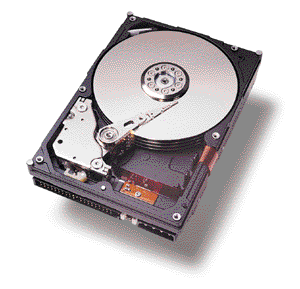
IBM Deskstar 8
A landmark drive from IBM which sold in tiny numbers. Hard on the heels of the record-breaking Travelstar 5GS notebook drive, the Deskstar 8 was the first 8GB IDE drive — easily the biggest and almost the fastest IDE drive money could buy. IBM's then-new Magneto-Resistive Extended (MRX) head technology allowed a new world-record areal density of 1.74 GBits/sq. in.
These were never a major seller, however, simply because the market was not yet ready for 8GB drives in any significant numbers — certainly not at the price that these started out at. When the Deskstar 8 came out, the most popular capacity points were 2.1 and 3.2GB, with 4.3GB drives just starting to take off. By the time prices had dropped and the market was ready to buy 8GB drives in quantity, there were even bigger and much faster drives available from both IBM and other makers — not least due to IBM's still more efficient Giant Magneto-Resistive head technology — and the Deskstar 8 remained very rare.
We sometimes wonder if this was just a local thing — we are in a small country town, after all — or if the Deskstar 8 was a very expensive loss maker for IBM that didn't come close to repaying its development costs. Perhaps, to take a longer view, this didn't matter. Every hard drive made in the world today uses GMR head technology, so it's reasonable to view some losses along the way as justified by the eventual result.
| Performance | 1.08 | Reliability | no data |
| Data rate | 127.4 Mbit/sec | Spin rate | 5400 RPM |
| Seek time | 9.5ms | Buffer | 512k |
| Platter capacity | 2.1GB | Interface | ATA-33 |
| Read channel | PRML | Head technology | MRX |
| DHEA-38451 | 8.45GB | 8 heads |


